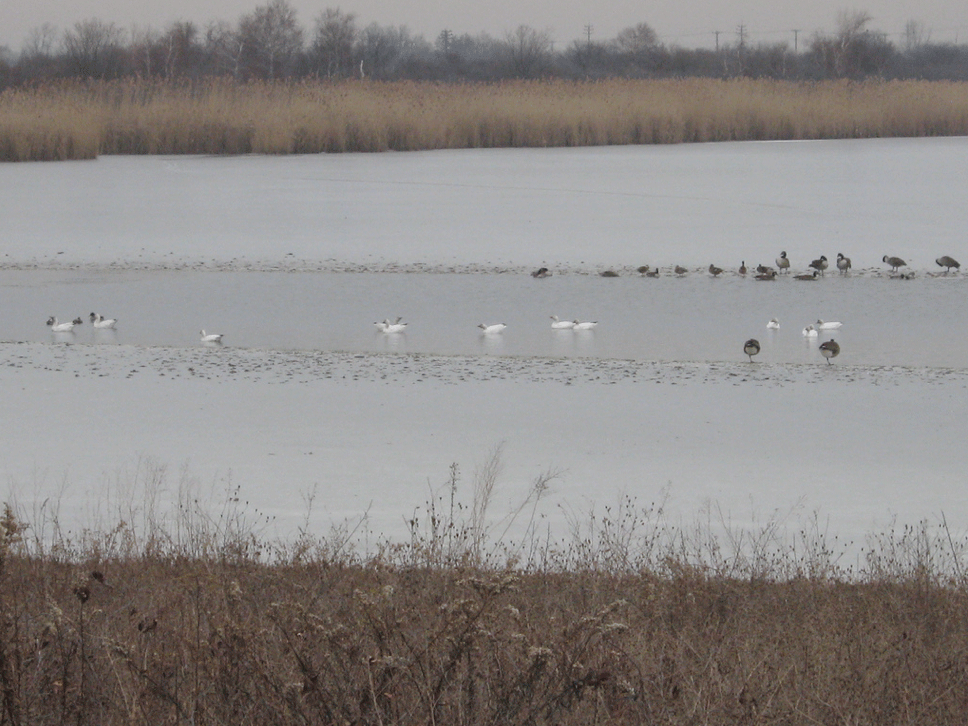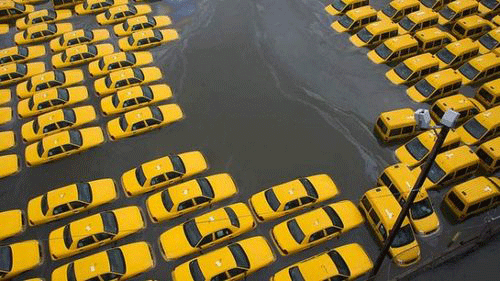Effects of Climate Change on New York City
Air Date: Week of November 2, 2012

Jamaica Bay Wildlife Refuge (Photo: Peter Roan)
We revisit a Living on Earth documentary reported by John Rudolph in 2003 that examined storm surges and other potential effects of climate change on New York City. Then Klaus Jacob, senior research scientist at Columbia University's Lamont-Doherty Earth Observatory, featured in the original story, talks to host Steve Curwood from his flooded home on the Hudson River.
Transcript
CURWOOD: It’s Living on Earth, I'm Steve Curwood. Sandy the super-storm has dominated the news, but there is an election on and the disaster helped engineer some unusual political fall-out. New Jersey's Republican governor, Chris Christie heaped praise on President Obama for his speedy responsiveness to the catastrophe.
And Michael Bloomberg made a last minute endorsement of Obama for re-election. The independent New York Mayor cited climate change as he praised the democratic president’s actions to cut emissions, and lamented Republican Mitt Romney’s opposition to capping global warming gases.
“One sees climate change as an urgent problem that threatens our planet; one does not,” Bloomberg wrote in an opinion piece. “I want our president to place scientific evidence and risk management above electoral politics.” Risk management was a key part of a documentary, "Degrees of Concern: Climate Change and New York City's Future," that we broadcast back in 2003.

New York City taxis underwater in the wake of Sandy (US Department of Transportation)
It examined the vulnerability of the Big Apple to flooding from a major ocean storm - such as Sandy. We visited Ground Zero - where the Twin Towers of the World Trade Center once stood - with Klaus Jacob, senior research scientist at Columbia University's Lamont-Doherty Earth Observatory, who described how Lower Manhattan could be inundated in a storm surge. Here's part of that story from reporter John Rudolph.
RUDOLPH: Professor Klaus Jacob looks out over the World Trade Center site and sees a potential disaster in the making. It’s not the threat of more terrorism. Jacob worries that in the coming decades whatever is built on the site will be vulnerable to the combination of rising seas and more intense storms aggravated by climate change.
JACOB: The frequency of such flooding events could increase on an average three times, but in the worst case as much as 10 times. So, what is right now a 50 year storm – which is roughly an eight-foot coastal storm surge here at this place where we stand – it could happen, instead of every 50 years, it could happen every five years. And that’s not good for a city that claims to be the world financial capital to see its financial infrastructure flooded every five years, and business interrupted, and all the things that go with it.
RUDOLPH: Now, as you said, there is a range of possibilities. There’s the best-case scenario. There’s the worst-case scenario. Does it really matter in terms of which of these scenarios you choose, in terms of the increased vulnerability of Ground Zero, of the subway entrances downtown, of the tunnel entrances downtown, and so forth?

Superstorm Sandy flooded large parts of New York’s subway system. (Department of Transportation)
JACOB: We have already a storm-surge problem. The Holland Tunnel is always on the verge of flooding during Nor’easters, and the PATH tunnel already has flooded, so we know what the current risk is. What’s so bad is that it will become more frequent, and so it’s actually more cost beneficial to do it now. Because the longer we wait, the less benefit we get because we may incur some losses before we do the measures, so why not do them now when we are all building this infrastructure anyhow, you know.
RUDOLPH: What kinds of specific measures are you suggesting should be taken now to protect this infrastructure from the kinds of storm surges that you’ve been talking about?
JACOB: Well, one good thing is that we already have created, again, some buffer zones on the waterfront towards the Hudson. Much of what was formerly industrial or harbor facilities have been turned into parkland, so that’s great. That’s a good measure. That’s a step in the right direction.
What has to be done for protecting both the infrastructure, but also buildings that are going up here is, we simply have to be aware that all critical entrances have to be at a certain level that exceeds the projected flooding levels. And we can discuss the details how to achieve it, and engineers will do a, probably, a very good job in doing this but it has to be brought into the planning.
RUDOLPH: When you look at the situation out in Jamaica Bay and then you stand here in front of Ground Zero, what’s the connection between the disappearing marshes in Jamaica Bay and the threat that Ground Zero and the Holland and midtown tunnels face?
JACOB: Well, I wish we would lose a piece of Manhattan just like we do out in Jamaica Bay every year, and then we would see it better. Okay? So far, we have engineered over it cosmetically but we really haven’t addressed the fundamental issues.
CURWOOD: Professor Klaus Jacob of Columbia University with reporter John Rudolph at Ground Zero in 2003. Well, Professor Jacob would presumably be justified in looking at the extraordinary destruction of super-storm Sandy - and saying 'I told you so'. So we called him up - and reached him on his cell phone….
[PHONE RINGING]
JACOB: Klaus Jacob
CURWOOD: Hi Klaus Jacob, Steve Curwood here at Living on Earth, how are you?
JACOB: Fine.
CURWOOD: You’re on your cellphone because you’ve lost power?
JACOB: That’s right, I’m a victim like many, many others here in New York and the New York area.
CURWOOD: How have you and your family fared in this storm?
JACOB: Well, we got hit. We had two feet of water in the house, and two cars flooded out, and no power, no gas, no electricity, no communication, except these cellphones.
CURWOOD: And what neighborhood are you in?
JACOB: We are in a small village called Piermont, New York, which is on the Hudson about five miles up from the Tappan Zee Bridge.
CURWOOD: And what’s the damage like in your neighborhood?
JACOB: A lot of boats got washed into the backyards of people - there is a marina. Many of the waterfront gardens were heavily damaged from the wave action, and the worst, I would say, about a third of the village was inundated with two feet or more of water - some up to five feet.
CURWOOD: Now, back in 2003, you said that Manhattan would need to get hit by serious flooding before officials would start to think seriously about the risks of climate change, particularly the storm surges, so do you think this year’s hurricane was enough of a wake-up call?
JACOB: Well, last year’s Irene should have been the wake-up call. And then we should have gotten into action. So this is the second wake-up call… how many wake-up calls do we need?
CURWOOD: Are you surprised by any of what you’ve seen about this? I mean, you saw this coming, but did you think it would be this bad for the city?
JACOB: Well, I mean, we had a scenario in which we went through the exercise about what a 100-year storm would do, and Sandy turned out to be pretty much that scenario that we investigated, and all of the consequences seemed to come true.
CURWOOD: We’re looking at the new reality here, Klaus Jacob?
JACOB: Well, yes, I have heard Governor Cuomo say that there’s a new reality, but that reality has been around for about ten years. What has changed is that we have incurred the losses.
CURWOOD: Now, back in 2003, you were encouraged about the development of buffer zones along the waterfront. What else should New York City do now to better prepare itself for these new realities?
JACOB: Well, first it needs to protect its infrastructure – the subways, the sewer water treatment plants, and the electric power plants and communication and many other things. Secondly, each owner near or on the waterfront or in a flood zone has to take some responsibility for his or her safety, and investment and businesses need to think about business continuity, so you can’t just leave it to the city or the state or the federal government, everybody has their task.
CURWOOD: If you had the ear of the mayor of New York right now, what would you say?
JACOB: I would say – enough of this talk, let’s get to action. First of all, you have to have good engineering plans, which hasn’t happened, we have general ideas of how we might go about. But, for instance, there are engineers within the MTA, the Metropolitan Transportation Authority, that have been thinking about how to approach this issue, but they haven’t been allowed by the management, and, if you like, by the legislature and the government because no money is available for really action. And that’s what we need. So, the engineers are in the starting bolts, but there is no gun for the race to begin.
CURWOOD: Now, some will say that this is a fluke - there was a big flood back in 1821, it will be another 100, 200 years before this happens again…
JACOB: Well, it’s amazing that with these political bodies, we are still talking whether that is a new reality. When you come from a science or technical plan, or even from a common sense, sea level rise… [phone cutting out…]
CURWOOD: We’re losing you, I think I’ll have to say goodbye and let you save your battery here… Klaus Jacob, thank you so much for taking this time with us today.
JACOB: You’re welcome, bye.
CURWOOD: Klaus Jacob is senior research scientist at Columbia University's Lamont-Doherty Earth Observatory.
Links
Living on Earth wants to hear from you!
Living on Earth
62 Calef Highway, Suite 212
Lee, NH 03861
Telephone: 617-287-4121
E-mail: comments@loe.org
Newsletter [Click here]
Donate to Living on Earth!
Living on Earth is an independent media program and relies entirely on contributions from listeners and institutions supporting public service. Please donate now to preserve an independent environmental voice.
NewsletterLiving on Earth offers a weekly delivery of the show's rundown to your mailbox. Sign up for our newsletter today!
 Sailors For The Sea: Be the change you want to sea.
Sailors For The Sea: Be the change you want to sea.
 The Grantham Foundation for the Protection of the Environment: Committed to protecting and improving the health of the global environment.
The Grantham Foundation for the Protection of the Environment: Committed to protecting and improving the health of the global environment.
 Contribute to Living on Earth and receive, as our gift to you, an archival print of one of Mark Seth Lender's extraordinary wildlife photographs. Follow the link to see Mark's current collection of photographs.
Contribute to Living on Earth and receive, as our gift to you, an archival print of one of Mark Seth Lender's extraordinary wildlife photographs. Follow the link to see Mark's current collection of photographs.
 Buy a signed copy of Mark Seth Lender's book Smeagull the Seagull & support Living on Earth
Buy a signed copy of Mark Seth Lender's book Smeagull the Seagull & support Living on Earth

